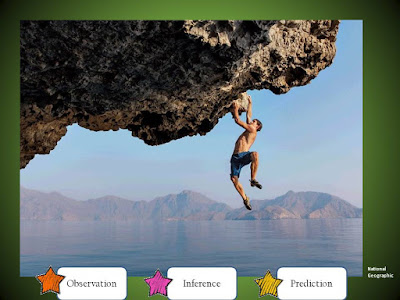What's going on in the picture?
So… start with something simpler.
Start with pictures.
Visuals take away the decoding load. All students can access them—regardless of reading level—and everyone has something to say.
Ask:
-
What do you notice?
-
What details stand out?
🌟 Tip: Use sentence stems like “I noticed…” or “It looks like…” to help students get started.
Have them Infer
Ask the same three questions:
Observation: What do you see?
Inference: What does that make you think?
Prediction: What might happen next?
This picture brings urgency and real-world context. And students love sharing wild (and thoughtful!) guesses about what might happen next.
Encourage forward thinking with this picture of a man dangling from a rock above water:
-
What might happen next?
-
How do you think the character is feeling?
My students and I look at more pictures to teach inference. Later, we move into small groups or partner work to answer the three questions: What do you observe? What do you infer? What do you predict?
Wait! Did she get into trouble? But she's kind of happy that she did? Like maybe she beat up a bully who was picking on other kids? And she's going to get into trouble for it, but she's still happy that she did it.
Make Inferences from Picture Books
Making Inferences from Text Alone
Use a text like Briar Rose (Sleeping Beauty) with guided supports like this:
-
Underlined clues in the text
-
Margin notes with inference starters
-
Questions that help them think beyond the words
What Happens Next
Over a few days, you’ll notice a shift.
Your students start asking better questions, noticing more details, and—best of all—feeling confident about their thinking.
🎉 That’s the real magic of inference.
Want to Save Time Planning?
If you’d rather skip the planning, I’ve bundled everything—pictures, prompts, scaffolded texts, and sentence starters—into a ready-to-use resource for upper elementary classrooms.






No comments
Post a Comment